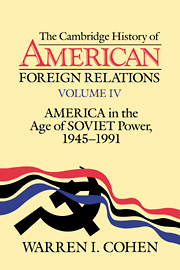Book contents
- Frontmatter
- Prelude
- 1 At war’s end: visions of a new world order
- 2 Origins of the Cold War
- 3 The Korean War and its consequences
- 4 New leaders and new arenas in the Cold War
- 5 Crisis resolution
- 6 America’s longest war
- 7 The rise and fall of Détente
- 8 In God’s country
- Conclusion: America and the world, 1945–1991
- Bibliographic essay
- Index
- THE CAMBRIDGE HISTORY OF AMERICAN FOREIGN RELATIONS
- References
4 - New leaders and new arenas in the Cold War
Published online by Cambridge University Press: 28 March 2008
- Frontmatter
- Prelude
- 1 At war’s end: visions of a new world order
- 2 Origins of the Cold War
- 3 The Korean War and its consequences
- 4 New leaders and new arenas in the Cold War
- 5 Crisis resolution
- 6 America’s longest war
- 7 The rise and fall of Détente
- 8 In God’s country
- Conclusion: America and the world, 1945–1991
- Bibliographic essay
- Index
- THE CAMBRIDGE HISTORY OF AMERICAN FOREIGN RELATIONS
- References
Summary
Stalin died. Slowly the terror eased within the Soviet Union, especially after those competing for primacy within the leadership rid themselves of Lavrenti Beria, dreaded head of the secret police. Georgii Malenkov, who, in 1953, seemed to be Stalin’s likely successor, sought to reduce international tensions as well. He called for peaceful coexistence with the capitalist world, held out his hand to Tito in Yugoslavia, and offered assurances of Soviet goodwill to Turkey, Iran, and Greece. Israel, India, and Japan similarly received indications that Stalin’s death might mean improved relations with the Soviet Union. But Malenkov’s hold on power was tenuous and those who vied with him were critical of his efforts to redirect foreign policy. It was not until after he was shunted aside, and Nikita Khrushchev continued his initiatives while providing a few of his own, that the main outlines of post-Stalinist policy were manifest.
The new Soviet leadership inherited a world in which the dominant power, the United States, had just undertaken a rapid military buildup and had demonstrated its ability to project its power many thousands of miles from its shores. Only weeks before Stalin’s death, a new administration had arrived in Washington, led by men who called for a more aggressive anti-Soviet policy, for the liberation of Eastern Europe, and for the “unleashing” of Chiang Kai-shek. These were people who would deny the Soviet Union the fruits of victory in World War II, deny the Soviets the influence and respect to which the world’s second most powerful nation was entitled.
- Type
- Chapter
- Information
- The Cambridge History of American Foreign Relations , pp. 81 - 120Publisher: Cambridge University PressPrint publication year: 1993



